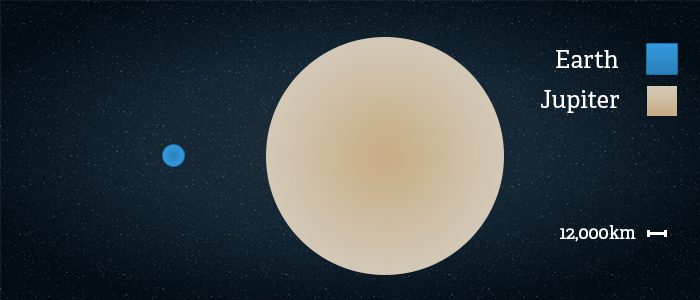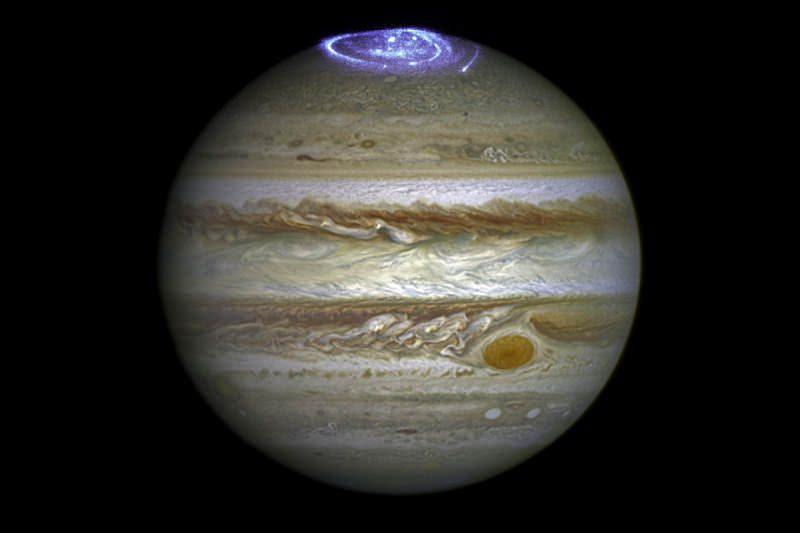
JUPITER PROFILE
| Mass: | 1,898,130,000,000,000,000 billion kg (317.83 x Earth) |
| Equatorial Diameter: | 142,984 km |
| Polar Diameter: | 133,709 km |
| Equatorial Circumference: | 439,264 km |
| Known Moons: | 67 |
| Notable Moons: | Io, Europa, Ganymede, & Callisto |
| Known Rings: | 4 |
| Orbit Distance: | 778,340,821 km (5.20 AU) |
| Orbit Period: | 4,332.82 Earth days (11.86 Earth years) |
| Surface Temperature: | -108°C |
| First Record: | 7th or 8th Century BC |
| Recorded By: | Babylonian astronomers |
Named after the Roman king of the gods, Jupiter is fitting of its name. With a mass of 1.90 x 1027 kg and a mean diameter of 139,822 km, Jupiter is easily the largest and most massive planet in the Solar System. To put this in perspective, it would take 11 Earths lined up next to each other to stretch from one side of Jupiter to the other and it would take 317 Earths to equal the mass of Jupiter.
SIZE OF JUPITER COMPARED TO THE EARTH

MOONS OF JUPITER
Jupiter has 67 confirmed moons orbiting the planet. These moons are separated into three groups:
- Inner moons. These orbit the closest to Jupiter and are sometimes called the Amalthea group. The names of the inner moons of Jupiter are Metis, Adrastea, Amalthea, and Thebe.
- Galilean moons. These are largest of Jupiter’s moons and were discovered by Galileo Galilei in 1610 – Io, Europa, Ganymede and Callisto.
- Outer moons. These moons are much smaller and further away from Jupiter. They also have irregular, elliptical orbit paths and many are captured asteroids.
More information about the moons of Jupiter
FACTS ABOUT JUPITER
- The first recorded sighting of Jupiter were by the ancient Babylonians in around 7th or 8th BC. It is named for Jupiter, the king of the Roman gods and god of the Sky. The Greek equivalent is Zeus, god of thunder. For the Mesopotamians, he was the god Marduk and patron of the city of Babylon. Germanic tribes saw the planet as Donar, also known as Thor.
- When Galileo discovered the four moons of Jupiter in 1610 this was the first proof of celestial bodies orbiting something other than Earth. The discovery also provided further evidence of Copernicus’ Sun-centred solar system model.
- Jupiter has the shortest day of the eight planets. The planet rotates very Jupiter rotates very quickly, turning on its axis once every 9 hours and 55 minutes. This rapid rotation is also what causes the flattening effect of the planet, which is why it has an oblate shape.
- One orbit of the Sun takes Jupiter 11.86 Earth years. This means that when viewed from Earth, the planet appears to move very slowly in the sky. It takes months for Jupiter to move from one constellation to the next.
- Jupiter has a faint ring system around it. Its ring is mostly comprised of dust particles from some of Jupiter’s moons during impacts from comets and asteroids. The ring system begins about 92,000 km above Jupiter’s clouds and reaches more than 225,000 km from the planet. The rings are somewhere between 2,000-12,500 km thick.
- Jupiter has at least 67 moons in satellite around the planet. This includes the four large moons called the Galilean moons that were first discovered by Galileo Galilei in 1610.
- The largest of Jupiter’s moons, Ganymede is the largest moon in the solar system. The moons are sometimes called the Jovian satellites and the largest of them are Ganymede, Callisto, Io and Europa. Ganymede is larger than the planet Mercury with a diameter of around 5,268 km.
- Jupiter has a very strong magnetic field. This is around 14 times stronger than the magnetic field found on Earth – the largest of any planet in the solar system.
- Jupiter is the fourth brightest object in our solar system. After the Sun, the Moon and Venus, Jupiter is the brightest and is one of five planets which can be seen by naked eye from Earth.
- Jupiter is the only planet that has a center of mass with the Sun that lies outside the volume of the Sun, though by only 7% of the Sun’s radius.
- Jupiter has a very unique cloud layer. The upper atmosphere of the planet is divided into zones and cloud belts which are made of ammonia crystals, sulfur and a mixture of these two compounds.
- Eight spacecraft have visited Jupiter so far. Those are Pioneer 10 and 11, Voyager 1 and 2, Galileo, Cassini, Ulysses and the New Horizons mission. Another mission, Juno, is set to arrive at Jupiter some time around July 2016. There are also plans for future missions to focus on the Jovian moons of Jupiter – Europa, Ganymede and Callisto – and their possible subsurface oceans.
- Jupiter does not experience seasons like other planets such as Earth and Mars.This is because the axis is only tilted by 3.13 degrees.
- Jupiter’s Great Red Spot is an enormous storm that has been raging for over 300 years. This storm is so wide that three Earth’s would fit inside of it.
- If Jupiter had become 80 times more massive, nuclear fusion would have occurred in its core. Had that happened, it would have become a star instead of a planet.
MORE INFORMATION AND FACTS ABOUT JUPITER
What is even more provocative is the theory that Jupiter is a failed star. Current scientific knowledge suggests that if Jupiter had, in fact, been roughly 80 times more massive, nuclear fusion would have taken place in its core; thus, Jupiter would have become a star, not a planet. Regardless, it is still tempting to look at the number of satellites orbiting Jupiter and consider it and its moons as, in many ways, a mini solar system.
Although our scientific knowledge of Jupiter has been greatly expanded as a result of the numerous planetary missions beginning in the 1970s, these missions are unnecessary for viewing the planet’s surface features. Instead, most of these features can be observed using Earth-based telescopes. For example, as recently as 1994, the Hubble Space Telescopeprovided stunning images of the impact of the Shoemaker-Levy 9 comet into Jupiter.
ATMOSPHERE
The vertical dimension (i.e., thickness) of Jupiter’s atmosphere is more difficult to define than those of the terrestrial planets. For example, whereas the lower boundary for the atmosphere on Earth is its solid planetary surface, there is no such equivalent on Jupiter. Essentially, Jupiter’s atmosphere transitions from a gaseous outer zone into the planet’s liquid layer. However, for practical purposes scientists have designated the depth at which the atmospheric pressure equals ten times the pressure at sea level on Earth as Jupiter’s “surface”.
Those layers of the atmosphere visible to Earth-based telescopes are divided into lighter and darker horizontal bands. Scientists believe these bands to be layers of high and low pressure. As a result, storms often develop on the boundaries between two adjacent bands. The Great Red Spot, visible in Jupiter’s southern hemisphere, is one such storm. Amazingly, this storm has raged for centuries and is 25,000 km across— is big enough to hold two Earths!
The composition of Jupiter’s atmosphere is very interesting. At roughly 90% hydrogen and 10% helium, Jupiter’s composition is nearly the same as the Sun’s. The only difference between the two is that the Sun is much more massive than Jupiter. This composition supports the theory that Jupiter could have been a star.
INTERIOR
The interior of Jupiter is believed to consist of three regions. The first is a rocky core composed of various elements with a mass between 12 and 45 times that of the entire Earth. The core is surrounded by the second region, a layer of electrically conductive liquid hydrogen. It is due to this layer, which comprises most of the planet’s mass, that Jupiter has such a strong magnetic field. The third region consists of ordinary hydrogen with traces of helium, which transitions into the planet’s atmosphere.
A fascinating property of Jupiter is that it emits more energy than it receives from the Sun. This is due to the planet being so massive. As a result of such a large mass, Jupiter exerts a strong gravitational force on itself, thus resulting in the compression of the planet as a whole. The cumulative effect of all this inward force is the production of a large amount of heat, which is then radiated into space.
ORBIT & ROTATION
With a mean orbital distance of 7.78 x 108 km, Jupiter is, on average, a little more than five times the distance from the Earth to the Sun. This means that it takes about 43 minutes for sunlight to reach Jupiter. Also, Jupiter’s orbital eccentricity of .04838 is fourth largest among the planets, giving it a perihelion of 7.41 x 108 km and an aphelion of 8.16 x 108 km. Jupiter’s year is about 4,333 Earth days in length— that’s about 12 times the length of one Earth year!
Jupiter’s axial tilt of 3.17° is extremely small, second lowest in the Solar System behind Mercury. What this means is Jupiter doesn’t experience seasons at all.
Two things stand out about Jupiter’s rotation. The first is its speed. At just under 10 hours, Jupiter has the shortest rotational period in the Solar System. (Saturn is a close second at 10.7 hours.) This quick rotational speed causes the planet to bulge near its equator, making it less spherical than most of the other planets. The second stand-out characteristic of Jupiter’s rotation is that different parts rotate at different speeds. This is due to Jupiter’s not being a solid body. For example, the polar atmosphere rotates about 5 minutes more slowly than that found at the equator.
RINGS
Although the rings of Saturn are well-known, it is uncommon to hear anything about Jupiter’s rings. Nevertheless, Jupiter does have a ring system. Jupiter’s rings are lesser known than Saturn’s (or even Uranus‘) because they are primarily composed of dust, which makes them difficult to see. The formation of these rings is believed to have come about through Jupiter’s gravity having captured material ejected from its moons.
AURORA
Recently the Hubble Space Telescope captured an amazing event on the North Pole of Jupiter. As you can see from the image below, Jupiter, like Earth, has an Aurora ( Northern Lights ) which instead of a mystical green like on Earth, appears to be an electric blue color.

Jupiter’s Aurora is a stunning electric blue whirl, which is actually ultraviolet. This means that you would not be able to see it as it is shown in the image above which is a composite image.